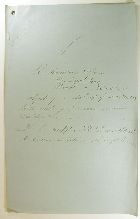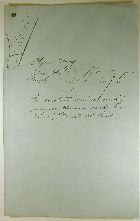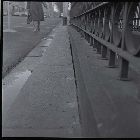Multimedia Content

Correspondence between Richardson & Son and Town Clerk, City of Melbourne, re Butchers Lane, 20 July 1872, courtesy of Public Record Office Victoria, Victorian Archives Centre.
Details
Correspondence file between Mary Flynn and Town Clerk, City of Melbourne, re the Gin Palace in Bourke St East, 1 February 1865, courtesy of Public Record Office Victoria, Victorian Archives Centre.
Details
Flinders Street South footpath., 14 July 1964, courtesy of City of Melbourne.
Details
Public Toilets
Growing awareness of the European vogue for public toilets, coupled with the opening of the Yan Yean water supply, led to a urinal being erected in 1859 by the Melbourne City Council (MCC) on the pavement in Bourke Street near Elizabeth Street. Though often criticised by adjacent city businesses as visual eyesores and affronts to respectability, public toilets were increasingly made available throughout the city to overcome the nuisances committed in back lanes and parks. The completion of the underground sewerage system led to the opening in 1902 of the first underground toilet at the corner of Russell and Bourke streets. While limited sanitary accommodation had been available to women at railway stations and some shops, this structure was the first to have a female compartment and was an outcome of strenuous petitioning from female citizens and women's groups, including the Women's Medical Society and the Women's Political Association of Victoria. By 1916 city conveniences included seven underground paying toilets, 28 street urinal stalls, and urinals and water-closets at the wharves, abattoirs, markets, Melbourne Town Hall, Viaduct Buildings, Princes Walk and in various parks. Melbourne's historic 1902 toilet has been decommissioned and, though capped and crowned with a public sculpture, remains substantially intact underground. A handful of extant above-ground cast-iron urinals are the remnant of about 40 structures erected between about 1903 and 1918. Cast by C. Monteath & Sons, ironfounders of South Melbourne, they employed a prefabricated interlocking post-and-panel system. As collections of national significance, the cast-iron and underground toilets are classified by the National Trust. A 1997 MCC review of public toilet provision led to further decommissioning of some of the historic collection, replaced by modern constructions with unisex and disabled access, to a design compatible with the existing street furniture. The oldest functioning public toilet is now the 1905 men's underground facility at the intersection of Queen and Collins streets.
